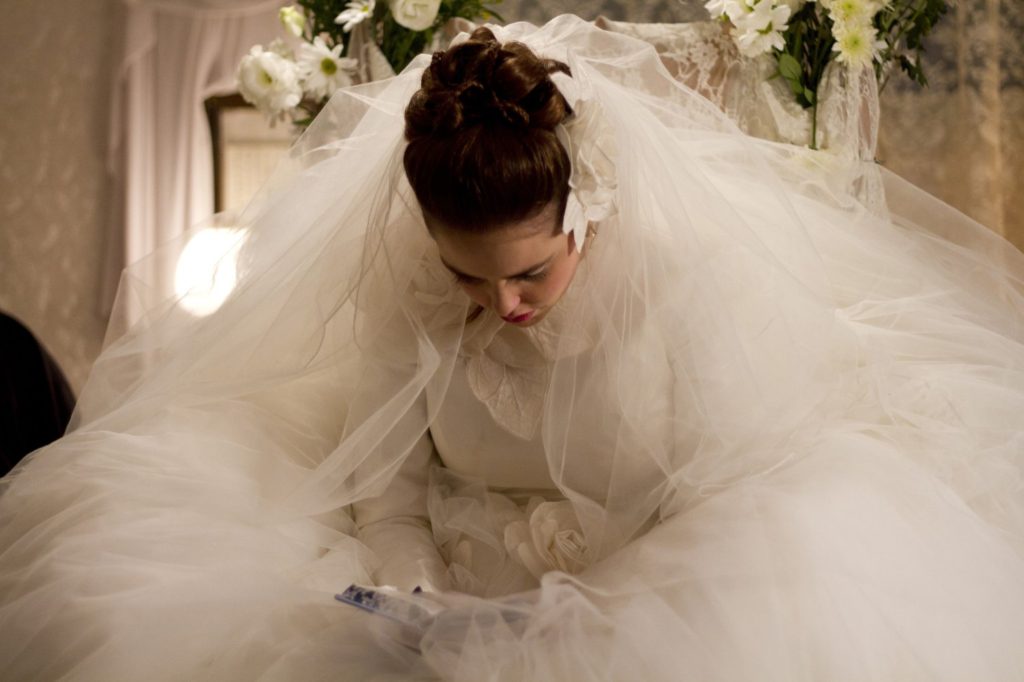Ancient Love In The Modern World
DIRECTED BY RAMA BURSHTEIN/HEBREW/2013 (USA release)
 There is something that makes a big fat Greek wedding Greek as opposed to Albanian. Custom. When spotting customs, it’s far easier to craft caricatures instead of explore complexities. On such a custom-spotting tour you may say, “Those people wear funny hats” or “I can’t believe they let their parents do that,” unaware that there is a similar tour commenting of us, “That baseball cap looks ridiculous” or “I can’t believe they let their kids do that.” It’s as absurd as seeing a work of art and imagining that the artist himself must live in a zany two-dimensional world. We judge entire peoples on these two-dimensional planes, without walking around their three-dimensional world. A world that makes as much sense to them as yours does to you.
There is something that makes a big fat Greek wedding Greek as opposed to Albanian. Custom. When spotting customs, it’s far easier to craft caricatures instead of explore complexities. On such a custom-spotting tour you may say, “Those people wear funny hats” or “I can’t believe they let their parents do that,” unaware that there is a similar tour commenting of us, “That baseball cap looks ridiculous” or “I can’t believe they let their kids do that.” It’s as absurd as seeing a work of art and imagining that the artist himself must live in a zany two-dimensional world. We judge entire peoples on these two-dimensional planes, without walking around their three-dimensional world. A world that makes as much sense to them as yours does to you.
Fill the Void explores the various dimensions of romance and duty in a tightly knit Hasidic community in modern day Tel Aviv. Shira (Hadas Yaron) is an 18 year-old woman eagerly awaiting her arranged engagement to a young suitor from New York. Her glee comes across slightly naive to the modern cynical viewer, but blossoms like a flower in her Austen-esque world of ceremony and formality. In her world, family is first and arranged marriage is not a custom; it’s life. Shira’s older sister Esther (Renana Raz), pregnant with her first child, helps answer questions about engagement and marriage. Esther’s husband, Yochay (Yiftach Klein), is the Mr. Darcy gold-standard by which Shira’s potential mate will be evaluated, and he does seem to be a genuinely good man.

A perfectly normal family photo.
Wine glasses are raised and celebratory songs ensue for the Jewish holiday of Purim. But soon after the last note is bellowed, tragedy strikes the family; Esther dies in childbirth, leaving Yochay with a child and a void. Shira is pressured by her matriarchal mother Rivka (Irit Sheleg) to marry Yochay so that he can stay in Tel Aviv and raise the child under the auspices of their devout community. The ensuing courtship is tentative and tense as it becomes clear that affection cannot be manufactured from duty. Shira receives advice from her disabled, single aunt—perhaps a comment on the helplessness of old unmarried women—as well as a challenge from her old-maid cousin Frieda, who also has an eye for Yochay. It is ultimately Shira’s decision whether or not to marry Yochay; she must weigh her sense of responsibility for her family with the desires of her own incipient freewill.
Visually, Fill the Void dwells in a calculated beauty that never strays far from shallow focus and feathered lighting.
Writer/Director Rama Burshtein, an Orthodox Jew herself, has crafted a fine debut. Her dialogue is understated and her plot is bare. She provides only a frame through which we can view this Orthodox community’s internal conformity and external non-conformity, letting the audience decide the appropriate level of grief, sympathy or disgust. Even in the final ambiguous shot, we must decide whether Shira believes she has made the right decision or not.
Fill the Void does not entertain many distractions in its character study. There are musical detours; sundry scenes of men belting out songs of celebration or grief as well as a score which heavily features an a capella choir extolling the virtues of Jerusalem. In one scene, Shira, a pre-school teacher’s assistant by day, is playing jovial tunes on her accordion for the children. Slowly, the music transitions into a lament as Shira is overtaken by her internal strife. In a moment of poignancy and rare comic relief, the confused children turn their heads to witness her somber face. It is not only dress and etiquette that tie this community back to their history; their bonds are in every word sung and note played.

Rama Burshtein has made a beautiful, meditative movie.
Visually, Fill the Void dwells in a calculated beauty that never strays far from shallow focus and feathered lighting. The characters seem to be superimposed onto their backdrops; out of step with the earth beneath them, but fully inhabiting the ethereal blooms of the firmament above. They shuffle around the cramped hallways of Tel-Aviv apartments, seemingly bumping against every table edge and doorframe, a thoughtful analogy of how tradition increasingly buts up against the steadily encroaching modern world.
Fill the Void will have limited appeal. It is a frustratingly slow movie, in Hebrew, rife with context heavy rituals. To the uninitiated, it may come across like a National Geographic spread about an unreached people group or perhaps like a foreign language soap opera. But underneath the fascinating, almost surreal trappings that surround this unique community, lies a common and captivating story of interdependence and self-will.

